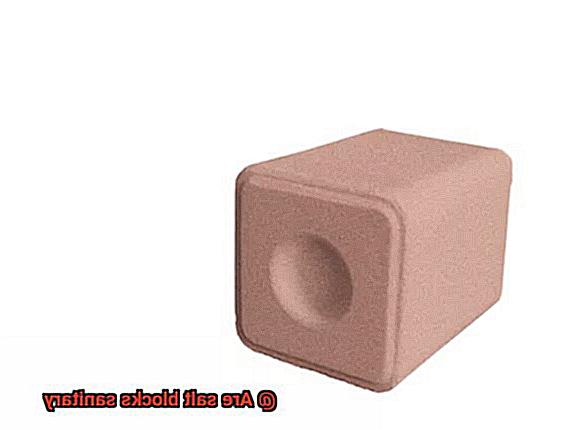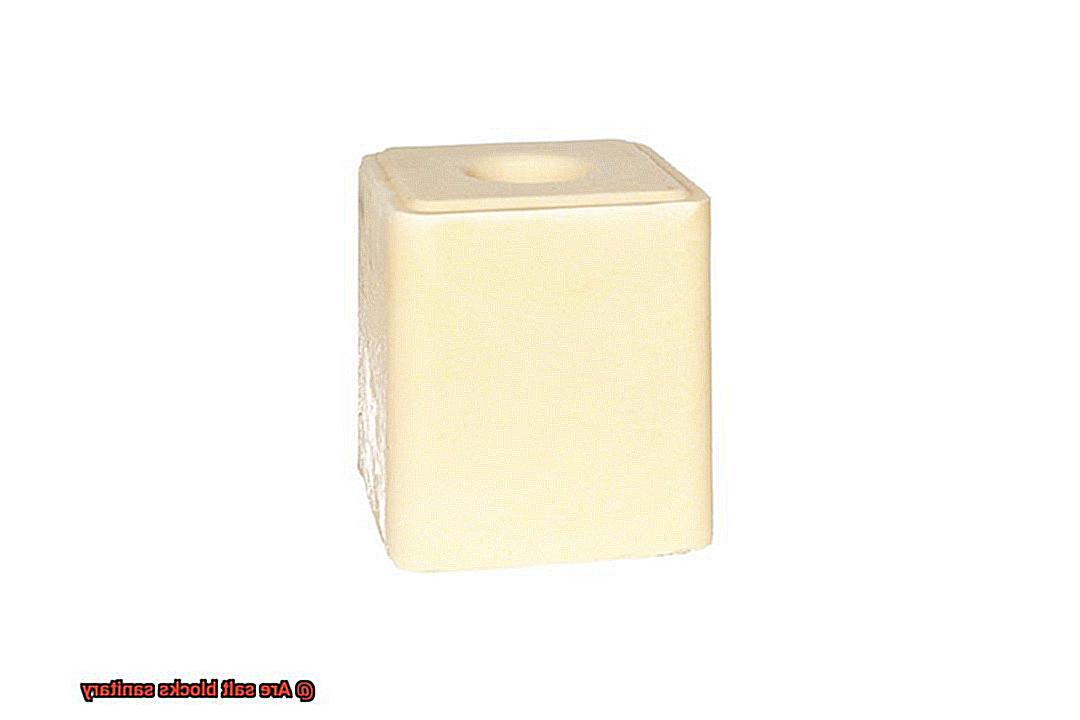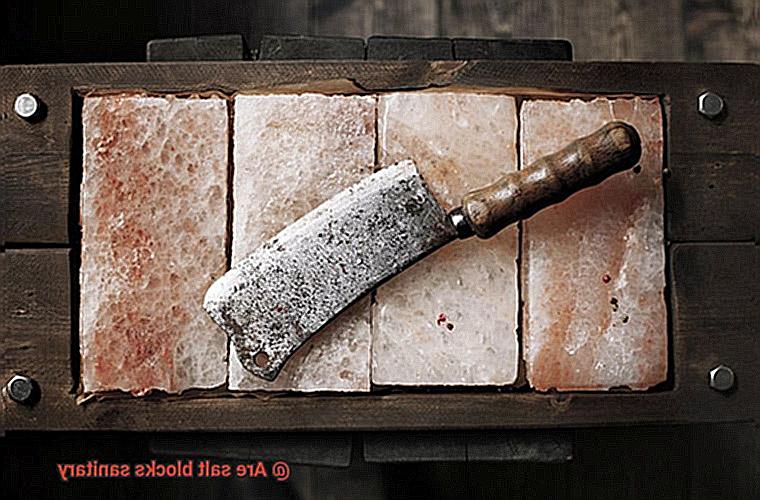Are you a foodie who loves to experiment with new ingredients and cooking techniques? If so, you’ve probably heard about the latest culinary trend – using salt blocks to cook and serve delicious meals. These slabs of pure Himalayan pink rock salt can be heated and used to sear meats, fish or vegetables, adding a subtle flavor that’s sure to impress your taste buds. And when used as serving platters for cold dishes, they add an elegant touch to any meal.
But before you start cooking up a storm on your salt block, you might be wondering: are they sanitary? It’s a valid concern, especially when handling raw meat or fish on a cooking surface. However, if you follow the proper cleaning and maintenance procedures, salt blocks are safe and hygienic.
So what exactly are these trendy slabs of salt? They’re cut and polished pieces of pure Himalayan pink rock salt that contain minerals known for their health benefits like regulating hydration and electrolyte balance. Plus, they add a touch of sophistication to any meal presentation.
In this blog post, we’ll explore how to clean, store, and maintain your salt block to ensure it stays sanitary for use in your kitchen. From scrubbing away residue after each use to storing it in a dry place between uses, we’ll cover all the tips and tricks you need for a successful salty culinary adventure. So let’s dive in.
Contents
Natural Antimicrobial Properties of Salt Blocks
Made from natural Himalayan salt, these blocks are renowned for their ability to preserve and enhance the flavor of food. But what makes them particularly appealing is their natural antimicrobial properties.
Salt has been used for centuries as a preservative to keep food fresh and free from harmful bacteria. When used as a cooking surface, salt blocks can also help kill bacteria that may be present on raw meat or other food products. The secret lies in osmosis – a process where salt draws out moisture from bacteria cells, causing them to rupture and die.
Apart from its incredible antimicrobial properties, salt also has other benefits when used as a cooking surface. It helps transfer heat evenly, resulting in more evenly cooked dishes. Additionally, it adds a subtle flavor to your culinary creations, which can be especially beneficial when grilling meats or vegetables.
However, it is essential to note that salt blocks aren’t entirely sanitary and can harbor bacteria if not cleaned and maintained properly. After each use, it is crucial to clean your block thoroughly with hot water and a stiff brush to prevent bacteria buildup. Avoid using soap as it can break down the salt and affect its flavor. Make sure to dry your block entirely before storing it.
Another critical aspect to keep in mind is to refrain from sharing your salt block between different types of foods. For instance, if you use your block for raw meat, make sure to clean it scrupulously before using it for vegetables.
How to Ensure Salt Block Sanitation
Cooking with a salt block can be a unique and flavorful experience. However, it is important to ensure that your salt block is properly sanitized to prevent the growth of harmful bacteria. Here are five sub-sections on how to ensure the sanitation of your salt block:
Thoroughly Clean Your Salt Block Before and After Each Use
To ensure that your salt block remains clean and sanitary, you must clean it before and after each use. Use a damp cloth or sponge to wipe away any debris from the surface of the block. If necessary, you can also use a mild soap solution to clean the block thoroughly. After cleaning, rinse the block with water and pat it dry with a clean towel.
Store Your Salt Block in a Dry, Cool Place
Proper storage is essential for maintaining the sanitation of your salt block. Store your salt block in a cool, dry place where it will not be exposed to moisture or humidity. This will help prevent the growth of bacteria and other harmful microorganisms on its surface.
Avoid Cross-Contamination
To avoid cross-contamination, it is important to use separate utensils for raw meats and other foods that may contain harmful bacteria. Additionally, do not touch the salt block with your hands repeatedly during cooking, as this can transfer bacteria onto its surface.
Do Not Use Your Salt Block for Raw Meats
Salt blocks should not be used to cook raw meats or other foods that may contain harmful bacteria. Instead, they should be used to cook vegetables, seafood, and other foods that are less likely to harbor harmful bacteria.
Replace Your Salt Block if It Becomes Damaged
If you notice any cracks or other signs of damage on your salt block, it is best to dispose of it and purchase a new one. Cracks can harbor bacteria and other harmful pathogens that can lead to foodborne illness.
Cleaning and Drying a Salt Block
Cooking with a salt block is an incredibly unique and flavorful experience, but it’s crucial to keep it clean to avoid any harmful bacteria or microorganism growth. As an expert on cleaning and drying a salt block, I have compiled a comprehensive guide on how to maintain your salt block’s sanitation and longevity.

Step 1: Let the Salt Block Cool Down

Before attempting to clean your salt block, ensure that it has cooled down completely. Trying to clean a hot salt block can cause it to crack or break. Allow it to cool down naturally before proceeding with the cleaning process.
Step 2: Wipe Away Any Debris
Once the salt block has cooled, wipe away any excess food or debris from its surface using a damp sponge or cloth. This step helps remove any leftover pieces of food that can harbor harmful bacteria.
Step 3: Use Warm Water and Baking Soda
Avoid using soap or harsh chemicals when cleaning your salt block as this can affect its taste and even cause it to break down over time. Instead, use a gentle mixture of warm water and baking soda to scrub away any stubborn stains or residue. Baking soda is an excellent natural cleaner that won’t affect the taste of your salt block.
Step 4: Dry Thoroughly
After cleaning your salt block, it’s essential to dry it thoroughly before storing it away. Leaving any moisture on its surface can cause it to dissolve and weaken over time. You can place it in a warm and dry place like an oven or on a sunny windowsill. Alternatively, you can use a clean cloth or paper towel to pat it dry.
Additional Tips:
- Avoid leaving your salt block in contact with water for extended periods as this can cause it to dissolve.
- If there are any particularly stubborn stains on your salt block, try using a gentle brush to scrub them away.
- Store your salt block in a dry and cool place to prevent any damage or cracking.
Avoiding Soap on a Salt Block
As a salt block aficionado, you understand the importance of keeping it in pristine condition for optimal use. However, using soap to clean your beloved salt block can actually do more harm than good.
Not only can soap leave a residue on the surface, negatively impacting the flavor of your food, but it can also break down the structure of the block and cause it to deteriorate faster. This is because salt is a natural antibacterial agent, and soap can strip away some of its beneficial properties.
Thankfully, there are alternative cleaning methods that will keep your salt block in top-notch shape. For example, a simple rinse with hot water and a gentle scrub with a brush or sponge works wonders. Alternatively, using a half lemon as a natural cleaning agent can break down any residue and leave the block smelling fresh.
It’s crucial to remember that salt blocks are porous and absorbent, so they should never be soaked in water or left to air dry. Instead, make sure to dry them thoroughly with a towel after cleaning to prevent any moisture from seeping into the pores of the block.
Keeping a Salt Block Dry and Away from Moisture
If you’re looking to keep your salt block dry and free from moisture, you’ve come to the right place. Here are some expert tips and tricks to help you maintain the sanitation of your precious salt block.
Firstly, it’s important to understand why keeping your salt block dry is crucial. Salt blocks are porous and absorbent, which means they can easily soak up moisture from their surroundings. This can lead to the growth of harmful bacteria and microorganisms, putting your health at risk and ruining the taste of your food.
So, how can you prevent this from happening? Here are three simple steps:
- Store it in a dry place: Avoid storing your salt block in damp areas like basements or garages. Instead, opt for a cool dry place like a pantry or cupboard.
- Use a drying agent: Silica gel packets or rice work great for absorbing excess moisture. Place them in an airtight container with the salt block or wrap them together with plastic before storing.
- Keep it away from liquids: To avoid any moisture from liquids or wet foods contaminating your salt block, place it on a dry surface when cooking. After use, wipe down the block with a dry cloth to remove any excess moisture.
By following these steps, you can ensure that your salt block remains clean and safe for use. Remember, taking care of your salt block is vital for maintaining its unique flavor-enhancing properties.
Not Sharing a Salt Block Between Different Types of Food
These versatile Himalayan salt blocks have become popular in many kitchens due to their unique flavor and ability to sear foods to perfection. However, it’s important to remember not to share a salt block between different types of food.
Here are five reasons why:
- Cross-Contamination: Salt blocks absorb the moisture and flavors of the food cooked on them. If you use the same block for different types of food, there’s a risk of cross-contamination. For example, if you cook chicken on the block and then use it for vegetables, the vegetables may end up with a chicken flavor and bacteria from the chicken.
-
Sanitation: While salt blocks have natural antimicrobial properties, they can still harbor bacteria. Proper cleaning and maintenance are necessary to ensure the block remains sanitary for cooking and serving food.
- Flavor: Using a salt block that has absorbed flavors from a previous dish can affect the taste of the next dish cooked on it. To ensure the best flavor, it’s recommended to use separate blocks for different types of food.
- Safety: Sharing a salt block between different types of food can lead to foodborne illness if harmful bacteria are transferred between foods.
- Proper Care: To maintain the integrity and flavor of your salt block, it’s important to clean it thoroughly after each use, avoid using soap or other cleaning products, and store it properly.
tp7mVn2qZSU” >
Conclusion
To sum it up, salt blocks are more than just a fancy kitchen accessory. They offer numerous health benefits and enhance the taste of your food in a unique way that can’t be replicated by any other cooking tool. However, it’s important to keep in mind that these blocks can also harbor harmful bacteria if not cleaned and maintained properly.
Don’t worry, though. Keeping your salt block sanitary is easy as long as you follow a few simple steps. First and foremost, always clean your block before and after each use with hot water and a scrub brush. Avoid using soap or harsh chemicals that could damage the block’s surface or alter its flavor-enhancing properties.
It’s also essential to store your salt block in a dry place away from moisture, which can cause mold or mildew to grow on the surface. And remember to avoid cross-contamination by only using one side of the block for each type of food.
Finally, if your salt block becomes damaged or develops deep cracks or crevices where bacteria could hide, it’s time to replace it. With proper care and attention, however, your salt block can provide years of delicious meals without posing any risk to your health.






